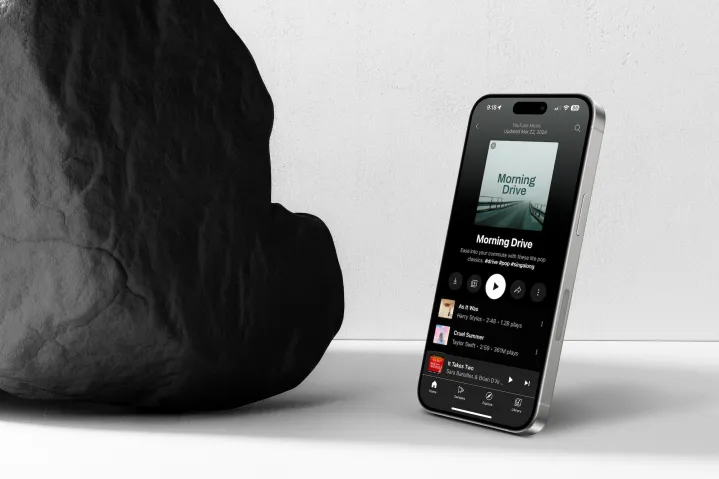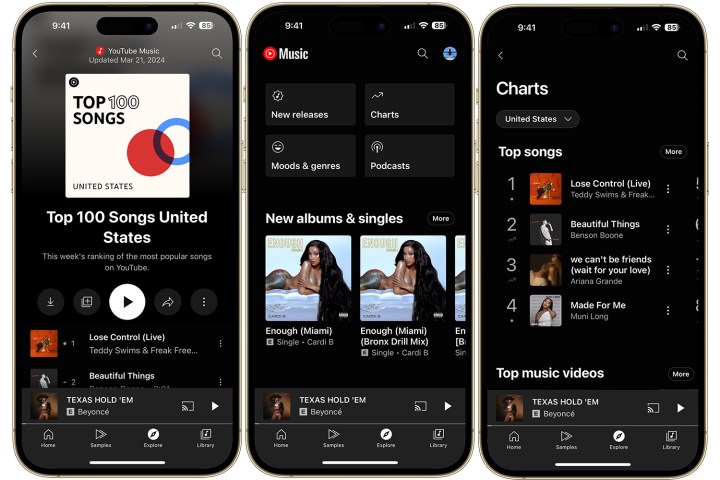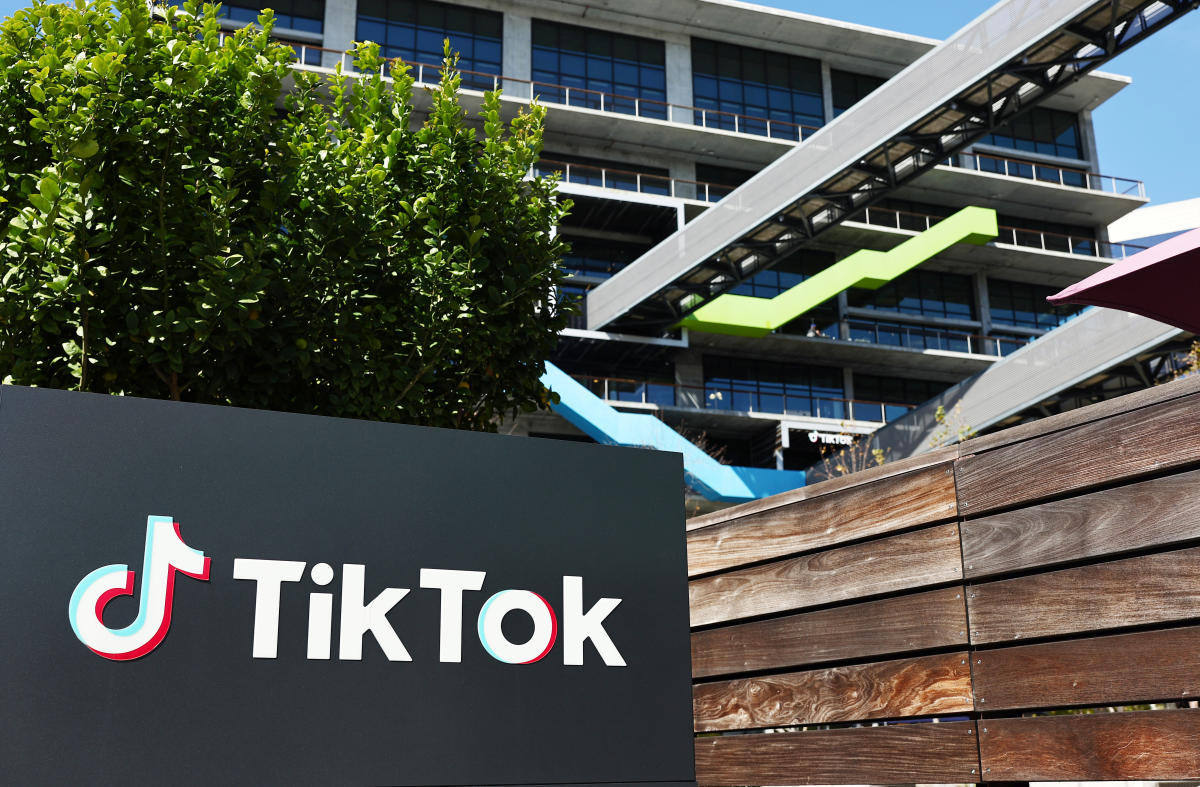Technology
What is YouTube Music? Everything you need to know


YouTube, long renowned for its vast video library, has quietly established itself as a formidable music streaming service. Its dedicated app, YouTube Music, offers a curated collection of songs, albums, and podcasts catering to various music lovers. With millions of songs and countless music videos, YouTube Music boasts a comprehensive catalog that rivals industry giants like Spotify and Apple Music.
The app utilizes advanced algorithms to suggest music based on your listening habits, ensuring a tailored and enjoyable experience. YouTube Premium subscribers can download their favorite tracks for offline playback, perfect for commutes, workouts, or areas with limited internet connectivity.
Suppose you’re wondering how YouTube Music compares to other music streaming services like Spotify, Tidal, or Apple Music. In that case, it depends on how frequently you rely on YouTube to search for music and how important music videos are to you. In this article, we’ll give you all the information you need to make an informed decision.
The basics

YouTube Music offers a simple, fast, minimalistic interface. With direct controls, it’s designed to get you to your favorite songs and music videos quickly. Its various sections include Home, Sample, Explore, and Library. The Home page contains your recommended songs, music videos, mixes, charts, and more. The Sample section, the newest service, features short video snippets curated based on your listening habits. Meanwhile, Explore allows you to discover new albums, while Library shows your listening history, favorite artists, and playlists.
YouTube Music uses your Google account information and history to personalize your experience. If you have been using YouTube to listen to music for some time, you will find prompts to add your favorite musicians and create a profile for recommendations. However, you can skip this step if you prefer. If left to its own devices, the app will automatically continue playing your past favorites.
Google introduced a link to Podcasts in the Home section in 2023. A glance at the section reveals that Google is not currently competing with Spotify and Apple Podcasts in terms of library size. Instead, the platform promotes podcasts that align with the listener’s musical preferences.
YouTube Music offers around 100 million tracks, which puts it in the same neighborhood as similar services like Amazon Music Unlimited, Apple Music, Spotify, Qobuz, and Tidal.
Free vs. Premium subscriptions
A free Google account allows free access to the YouTube music and podcast library. However, free users must deal with limitations such as occasional ads, no access to background playback, and limited control over song selection when listening to radio stations or playlists.
By subscribing to YouTube Music Premium, you can remove ads, listen to content in the background, download content for offline use, and skip songs with no limitations.
You automatically have a YouTube Music Premium subscription if you are a YouTube Premium subscriber.
Audio quality
YouTube Music offers several different audio tiers you can switch between depending on how much bandwidth you are comfortable with taking up. These tiers also dictate how much audio will download onto your device and the size of those files:
- Low: This sets the bit rate to 48kbps AAC, which uses the least data.
- Normal: This is the default setting for YouTube Music and is set at 128kbps AAC. It balances data usage and sound quality.
- High: This option sets the bit rate to 256kbps AAC, and is ideal for locations with solid internet connections.
- Always High: This feature uses a bit rate of 256kbps AAC, but prioritizes high audio quality even with a weak internet connection, resulting in increased data usage.
You can switch between these anytime by heading to the YouTube Music settings. Downloads for offline listening provide you with standard audio files. YouTube Music does not offer the ability to listen to or download hi-res audio files — that’s one area where features like Apple, Tidal, and Amazon Music’s Hi-Fi tiers, among others, can go well beyond what YouTube Music is capable of. If audio quality is your top concern when subscribing to a service, YouTube Music isn’t the best choice. Still, it’s a very competitive option if you are interested in reliable streaming.
How much is YouTube Music?
After the free YouTube Music plan, there are three YouTube Music Premium plans to choose from, depending on your situation:
- Individual plan: $11 per month (you can cancel anytime); $110 (when paid annually, for a savings of 15%)
- Family plan: $17 per month (share with up to five family members living in the same household)
- Student plan: $5.50 per month (this requires student verification)
New subscribers can try YouTube Music Premium free for 30 days.
Platform compatibility
YouTube Music provides two ways to access its service: a web browser and a standalone app. The web browser option is suitable for using a desktop or laptop computer. However, you can download the app if you’d like to use the service on mobile devices like Android, Google/Android TV, ChromeOS, iOS, or WearOS for the Apple Watch. You can also easily cast the music video or any other content to a compatible screen using Chromecast.
Features and music discovery

Excellent video integration
Music videos are integrated into the music player and play automatically if they are available with a song (otherwise, you get album art). The videos will downsize and stay in the corner if you navigate elsewhere in the YouTube Music app. There are also options to search for live performances and similar categories specifically. That makes YouTube Music one of the best options if you like music videos or want a visual component in the background while listening to music.
Playlists and playback
You can also choose to create an automatic playlist based on what music videos you’ve liked and listened to in the past, or create a new playlist of your own and add songs — with options to make it public on your YouTube channel or set it as private. You can also do a lot with any song you’re looking at. Select the Dropdown menu to a song, and you’ll see options to play it next, add it to your current queue, add it to a playlist or your liked songs, learn more about the artist, and more.
Music discovery
YouTube Music will also produce automated mixes based on your favorite artists and radio station recommendations featuring the artists you like listening to. My Supermix is a great way to discover new music and many other genre-based new release mixes. You’ll also find recommendations from broadly popular playlists, current chart-toppers, specific genres, and more. If you like playlists, you’ll find a lot to love here, but YouTube doesn’t have any human-curated options, so you’ll have to put your faith in the algorithm.
Fine-tuner
With the “Your Music Tuner” feature, you can create radio stations featuring music from up to 30 artists. The feature can be tweaked to your preferences, such as whether you want it to include only the artists you added or whether it’s OK to include similar artists.
Technology
Texas is suing TikTok for allegedly violating its new child privacy law

Texas Attorney General Ken Paxton has filed a lawsuit against TikTok claiming the company violated a new child privacy law in the state. It’s set to be the first test of Texas’ Securing Children Online Through Parental Empowerment (SCOPE) Act since it went into effect just over a month ago.
Under the law, parts of which were struck down by a federal judge, social media platforms are required to verify the ages of younger users and offer parental control features, including the ability for parents to opt their children out of data collection.
Paxton alleges that TikTok’s existing parental control features are insufficient. “However, Defendants do not provide the parents or guardians of users known to be 13 to 17 years old with parental tools that allow them to control or limit most of a known minor’s privacy and account settings,” the lawsuit states. “For example, parents or guardians do not have the ability to control Defendants’ sharing, disclosing, and selling of a known minor’s personal identifying information, nor control Defendants’ ability to display targeted advertising to a known minor.”
The lawsuit also argues that the app’s “Family Pairing” tool isn’t “commercially reasonable” because it requires parents to make their own TikTok account and because teens are free to deny their parents’ requests to set up the monitoring tool. TikTok didn’t immediately respond to a request for comment. The app already prohibits most targeted advertising to anyone younger than 18.
“We strongly disagree with these allegations and, in fact, we offer robust safeguards for teens and parents, including family pairing, all of which are publicly available,” the company said in a statement shared on X. “We stand by the protections we provide families.”
The lawsuit adds to TikTok’s growing legal challenges in the United States. The company is currently fighting a law that could result in a total ban of the app in the United States. It’s also facing a separate Justice Department lawsuit related to child privacy.
Update, October 3, 2024, 8:05 PM ET: This story has been updated to add a statement from TikTok.
Servers computers
Dell PowerEdge M630 Gen13 Server Blade Review

The Dell M630 is a member of the 13th generation PowerEdge server line and is designed for the M1000e blade enclosure or the PowerEdge VRTX shared infrastructure platform. The M630 offers exceptional scalability for remote offices, private clouds, applications in R&D, high-performance computing, and a range of virtualization options.
The M630 Blade is designed to meet growing IT demands with a scalable architecture and rapid access to additional storage in the form of NAS and SAN. This flexible two-socket blade offers in-server storage and performance allowing administrators to configure each blade to the workload requirements across a variety of tasks. Over the long haul, Administrators can realize a lower cost of ownership with the dense storage, performance, and shared infrastructure solutions supported by the M630.
For pricing on Dell’s PowerEdge M630 13G blade server click the link below.
http://www.itcreations.com/dell/DELL-POWEREDGE-M630.html
If you would rather speak to one of our knowledgeable sales staff give us a call
+1 800 237-0402 or send us an email sales@itcreations.com
Like Discounts? Sign up for our eNewsletter for discounts, tech-related information, and videos on new products!
http://eepurl.com/8tq6v
See more Dell servers offered by IT Creations:
http://www.itcreations.com/dell/index.html
See more HP servers offered by IT Creations:
http://www.itcreations.com/hp/index.html
Lenovo servers offered by IT Creations:
http://www.itcreations.com/lenovo/index.html
IBM servers offered by IT Creations:
http://www.itcreations.com/ibm/index.html
Fujitsu servers offered by IT Creations:
http://www.itcreations.com/fujitsu/index.html
Dell Workstations offered by IT Creations, Inc.:
http://www.itcreations.com/workstation-dell/
HP Workstations offered by IT Creations, Inc.:
http://www.itcreations.com/workstation-hp/index.html
See Lenovo workstations offered by IT Creations:
http://www.itcreations.com/workstation-ibm/index.html
Use the Share button above to LIKE, share, and comment on the video!
If you have questions, please feel free to contact us by email at sales@itcreations.com or call us
+1 800 237-0402 .
source
Technology
How GPT-4o Defends Identities Against AI-Generated Deepfakes

Join our daily and weekly newsletters for the latest updates and exclusive content on industry-leading AI coverage. Learn More
Deepfake incidents are surging in 2024, predicted to increase by 60% or more this year, pushing global cases to 150,000 or more. That’s making AI-powered deepfake attacks the fastest-growing type of adversarial AI today. Deloitte predicts deepfake attacks will cause over $40 billion in damages by 2027, with banking and financial services being the primary targets.
AI-generated voice and video fabrications are blurring the lines of believability to hollow out trust in institutions and governments. Deepfake tradecraft is so pervasive in nation-state cyberwarfare organizations that it’s reached the maturity of an attack tactic in cyberwar nations that engage with each other constantly.
“In today’s election, advancements in AI, such as Generative AI or deepfakes, have evolved from mere misinformation into sophisticated tools of deception. AI has made it increasingly challenging to distinguish between genuine and fabricated information,” Srinivas Mukkamala, chief product officer at Ivanti told VentureBeat.
Sixty-two percent of CEOs and senior business executives think deepfakes will create at least some operating costs and complications for their organization in the next three years, while 5% consider it an existential threat. Gartner predicts that by 2026, attacks using AI-generated deepfakes on face biometrics will mean that 30% of enterprises will no longer consider such identity verification and authentication solutions to be reliable in isolation.
“Recent research conducted by Ivanti reveals that over half of office workers (54%) are unaware that advanced AI can impersonate anyone’s voice. This statistic is concerning, considering these individuals will be participating in the upcoming election,” Mukkamala said.
The U.S. Intelligence Community 2024 threat assessment states that “Russia is using AI to create deepfakes and is developing the capability to fool experts. Individuals in war zones and unstable political environments may serve as some of the highest-value targets for such deepfake malign influence.” Deepfakes have become so common that the Department of Homeland Security has issued a guide, Increasing Threats of Deepfake Identities.
How GPT-4o is designed to detect deepfakes
OpenAI’s latest model, GPT-4o, is designed to identify and stop these growing threats. As an “autoregressive omni model, which accepts as input any combination of text, audio, image and video,” as described on its system card published on Aug. 8. OpenAI writes, “We only allow the model to use certain pre-selected voices and use an output classifier to detect if the model deviates from that.”
Identifying potential deepfake multimodal content is one of the benefits of OpenAI’s design decisions that together define GPT-4o. Noteworthy is the amount of red teaming that’s been done on the model, which is among the most extensive of recent-generation AI model releases industry-wide.
All models need to constantly be training on and learning from attack data to keep their edge, and that’s especially the case when it comes to keeping up with attackers’ deepfake tradecraft that is becoming indistinguishable from legitimate content.
The following table explains how GPT-4o features help identify and stop audio and video deepfakes.

Key GPT-4o capabilities for detecting and stopping deepfakes
Key features of the model that strengthen its ability to identify deepfakes include the following:
Generative Adversarial Networks (GANs) detection. The same technology that attackers use to create deepfakes, GPT-4o, can identify synthetic content. OpenAI’s model can identify previously imperceptible discrepancies in the content generation process that even GANs can’t fully replicate. An example is how GPT-4o analyzes flaws in how light interacts with objects in video footage or inconsistencies in voice pitch over time. 4o’s GANS detection highlights these minute flaws that are undetectable to the human eye or ear.
GANs most often consist of two neural networks. The first is a generator that produces synthetic data (images, videos or audio) and a discriminator that evaluates its realism. The generator’s goal is to improve the content’s quality to deceive the discriminator. This advanced technique creates deepfakes nearly indistinguishable from real content.

Voice authentication and output classifiers. One of the most valuable features of GPT-4o’s architecture is its voice authentication filter. The filter cross-references each generated voice with a database of pre-approved, legitimate voices. What’s fascinating about this capability is how the model uses neural voice fingerprints to track over 200 unique characteristics, including pitch, cadence and accent. GPT-4o’s output classifier immediately shuts down the process if any unauthorized or unrecognized voice pattern is detected.
Multimodal cross-validation. OpenAI’s system card comprehensively defines this capability within the GPT-4o architecture. 4o operates across text, audio, and video inputs in real time, cross-validating multimodal data as legitimate or not. If the audio doesn’t match the expected text or video context, the GPT4o system flags it. Red teamers found this is especially crucial for detecting AI-generated lip-syncing or video impersonation attempts.
Deepfake attacks on CEOs are growing
Of the thousands of CEO deepfake attempts this year alone, the one targeting the CEO of the world’s biggest ad firm shows how sophisticated attackers are becoming.
Another is an attack that happened over Zoom with multiple deepfake identities on the call including the company’s CFO. A finance worker at a multinational firm was allegedly tricked into authorizing a $25 million transfer by a deepfake of their CFO and senior staff on a Zoom call.
In a recent Tech News Briefing with the Wall Street Journal, CrowdStrike CEO George Kurtz explained how improvements in AI are helping cybersecurity professionals defend systems while also commenting on how attackers are using it. Kurtz spoke with WSJ reporter Dustin Volz about AI, the 2024 U.S. election and threats posed by China and Russia.
“And if now in 2024 with the ability to create deepfakes, and some of our internal guys have made some funny spoof videos with me and it just to show me how scary it is, you could not tell that it was not me in the video,” Kurtz told the WSJ. “So I think that’s one of the areas that I really get concerned about. There’s always concern about infrastructure and those sort of things. Those areas, a lot of it is still paper voting and the like. Some of it isn’t, but how you create the false narrative to get people to do things that a nation-state wants them to do, that’s the area that really concerns me.”
The critical role of trust and security in the AI era
OpenAI’s prioritizing design goals and an architectural framework that puts defake detection of audio, video and multimodal content at the forefront reflect the future of gen AI models.
“The emergence of AI over the past year has brought the importance of trust in the digital world to the forefront,” says Christophe Van de Weyer, CEO of Telesign. “As AI continues to advance and become more accessible, it is crucial that we prioritize trust and security to protect the integrity of personal and institutional data. At Telesign, we are committed to leveraging AI and ML technologies to combat digital fraud, ensuring a more secure and trustworthy digital environment for all.”
VentureBeat expects to see OpenAI expand on GPT-40’s multimodal capabilities, including voice authentication and deepfake detection through GANs to identify and eliminate deepfake content. As businesses and governments increasingly rely on AI to enhance their operations, models like GPT-4o become indispensable in securing their systems and safeguarding digital interactions.
Mukkamala emphasized to VentureBeat that “When all is said and done, though, skepticism is the best defense against deepfakes. It is essential to avoid taking information at face value and critically evaluate its authenticity.”
Source link
Technology
The final agenda for the Space Stage at Disrupt 2024

We’re out-of-this-world excited to announce that we’ve finalized our dedicated Space Stage at TechCrunch Disrupt 2024. It joins Fintech, SaaS and AI as the other industry-focused stages — all under one big roof. To top it off, we’re thrilled to share we’ll be hosting a pitch competition this year called “The Space Challenge, powered by Aerospace” as part of the event.
The full Space Stage agenda at Disrupt 2024
As the space industry accelerates, new opportunities proliferate for founders, investors and customers. Not only are the once-astronomical costs of doing business in orbit falling but so are the technical barriers to entry.
More stakeholders in space make for a lively, diverse and highly competitive environment crossing private and public markets — not to mention the fast-growing dual-use segment. Discover the challenges and possibilities waiting in orbit at Disrupt’s Space Stage, where you’ll hear from leaders across the industry.
Check out the final agenda below — we’ll see you there!
Startups in Dual-Use
with John Gedmark (Astranis), Even Rogers (True Anomaly), Melanie Stricklan (Space Workforce 2030), Tim Solms (Slingshot Aerospace)
Government and defense are relying more and more on commercial services, but startups face a real challenge entering this highly regulated and formal side of the industry. How can young, lean companies compete for contracts and attention with primes and more established organizations — and how can investors help?
Future of Space Operations Startup Challenge
Presented by the Aerospace Corporation
with Cody Bronkar (SpaceWERX), Debra Emmons (The Aerospace Corporation), and Justin Krauss (J.P. Morgan)
TechCrunch and the Aerospace Corporation are once again joining forces for the Space Challenge pitch competition. The contest is designed to foster the growth and development of innovative startups poised to transform commercial space operations. By engaging the founder and innovator community, venture capitalists and the commercial industry, this session will cast a wide net, attracting startups from both the space sector and beyond. Applications are now closed, but this is an event you won’t want to miss.
Peter Beck Takes the Space Industry by the Fins
with Peter Beck (Rocket Lab)
As the founder and CEO of Rocket Lab, Peter Beck is a familiar face to anyone in the space industry. But the company’s ambitions go far beyond its popular Electron launch vehicle: Beck believes that to thrive, perhaps even to survive, space companies will have to become fully integrated one-stop shops. Hear how Rocket Lab is pursuing this ambitious goal.
The Future of Launch
with Kelly Hennig (Stoke Space) and Muhammad “Mo” Shahzad (Relativity Space)
Launch has already been reinvented over the last decade, but why stop there? The demand for space is growing as fast as launch cadences permit, but there is an opportunity beyond making rockets and vehicles. Startups will likely define the future of launch-related software, automation, and operations if these founders have anything to say about it.
Bridgit Mendler on Moving from Disney Star to Startup Founder
with Bridgit Mendler (Northwood Space)
Former Disney Channel star Bridgit Mendler wants to transform one of the least sexy segments of the space industry: ground stations. In this fireside, we’ll learn more about how Northwood Space will build out a data highway between Earth and orbit.
Riding the Wave: The Future of Space Investing
with Lewis Alun Jones (Seraphim Space), Katelin Holloway (Seven Seven Six), Jordan Noone (Embedded Ventures)
Private investments in commercial space companies have exploded over the past few years but investor appetite has been tempered more recently by higher interest rates, turbulent space stock performance and geopolitical uncertainties. In this talk, we’ll discuss the future of space tech investing, which areas are oversaturated or undervalued, and whether this year will be make-it-or-break-it for space startups.
Explore the future of space innovation at Disrupt
TechCrunch Disrupt is where you’ll find innovation for every stage of your startup journey. Whether you’re a budding founder with a revolutionary idea, a seasoned startup looking to scale or an investor seeking the next big thing, TechCrunch Disrupt offers unparalleled resources, connections and expert insights to propel your venture forward. Over 10,000 startup and VC leaders will be attending this year’s event, taking place October 28-30 at Moscone West in San Francisco.
Blast off with us as top space leaders take the stage at Disrupt 2024! Secure your tickets now and be a part of the exploration journey.
Servers computers
Powerful Dell R940 Rack Server For Businesses in UAE

Buy New Dell PowerEdge R940 Rack Server – https://www.serverbasket.ae/dell-poweredge-r940-rack-server.html
For Complete Information on Dell PowerEdge R940 Rack Server, Please Contact Us at:
Website: https://www.serverbasket.ae
Email: sales@serverbasket.ae
Contact No: +971 50520 3535
Whatsapp No: +971 50520 3535
——————————————————————————————————–
Subscribe To Our Channel @ https://www.youtube.com/channel/UCXxaNw3P6OdkW29dMgTsv2A?
——————————————————————————————————–
Check out the Powerful Dell PowerEdge R940 Rack Server
Key Benefits:
– Breathtaking Performance For Mission-Critical Workloads
– Automate Maintenance With Dell EMC OpenManage
– Fortify Your Data Center With Comprehensive
– Server Everest
– Versatile Design
– Easy To Use
– Best Price in Market
– Instant Delivery
– Quick Support
Dell PowerEdge R940 Rack Server Specifications:
CPU Capacity:
– Supports 4 Processors
– Intel® Xeon® Scalable Processors
– Single CPU: 28 Cores Max
– Quad CPU: 112 Cores Max
– Max VCPUs: 224 – 168 VCPUs
RAM Capacity:
– Inbuilt 48 DIMM Slots
– 128 GB Max Memory Per DIMM Slot
– 6 TB Maximum Memory Capacity
– Supported Technology: DDR4 Memory
Storage Capacity:
-Up To 24×2.5″ SAS/SATA (HDD/SSD)
-Up To 12 NVMe PCIe SSD
Max potential Storage: 184.32 TB
Storage Controllers:
-Internal controllers: PERC S140, H330, H740P
-Boot optimized Storage Subsystem
-External HBAs (RAID): H840
-External HBAs (non-RAID): 12 Gbps SAS HBA
Power Supply:
Platinum 1100W, 1600W,
2000W, 2400W, 336-
380VDC 1100W,
Gold 48VDC 1100W
Hot plug power supplies with full redundancy option
8 hot plugs fans with full redundancy
Operating System:
-Canonical® Ubuntu® LTS
-Citrix® XenServer®
-Microsoft Windows Server® with Hyper-V
-Red Hat® Enterprise Linux
-SUSE® Linux Enterprise Server
-VMware® ESXi
I/O & Ports:
-Network daughter card options
-4x 1Gb, 4x 10Gb, 2x 10Gb+2x 1Gb, or 2x 25Gb
-Front ports: Video, 2 x USB 3.0, dedicated IDRAC Direct USB
-Rear ports: Video, serial, 2 x USB 3.0, dedicated iDRAC network port
-Video card: VGA
-Up to 13 x Gen3 slots, (3 x8 + 10 x16)
————————————————————————————
Check out the Powerful Dell PowerEdge R940 Rack Server from Server Basket.
#DellR940 #DellPowerEdgeR940Server #DellR940RackServer #ServerBasketUAE .
source
Technology
The new Ford Expedition adds Android Automotive and half of the Lincoln’s panoramic screen

The new Expedition, which is first being teased with a drone light show today in Texas, looks like it has only the left half of the Lincoln’s 48-inch pillar-to-pillar panoramic display, leaving behind just a 24-inch panel for the Expedition.
You’re getting the same instrument cluster and navigation combo in front of the driver’s seat, but without the widgets that feature on the right half of the Lincoln’s extended screen. The Expedition’s smaller center touchscreen that lives below it also runs Google Play Store apps, operates Apple CarPlay, and has digital HVAC controls, just like the Lincoln. The car also offers both Google Assistant and Alexa voice assistants (one at a time), and some models offer BlueCruise hands-free driving.
Pillar-to-pillar panoramic screens have become a flashy feature manufacturers have trotted out for their most luxurious vehicles recently. They’ve often been pitched as an infotainment hub for the front passenger, letting them watch streaming videos and even play some PlayStation.
Ford is selling a standard-wheelbase Expedition and an extended “Max” one. In the center row, you have options for bench seating or captain chairs; the backs of the first-row headrests have clamps that can hold smartphones or tablets for passengers in the center row. The Expedition can seat up to eight people with the bench option.
At first glance, the Expedition seems like a copy of the new Lincoln Navigator with its split rear gate, the addition of a light bar up front, and a similar 3.5-liter V6 engine under the hood. (It’s an “EcoBoost” for the Ford.) A new Tremor trim for the Expedition puts out up to 440 horsepower and has tuned suspension and unique trail modes for more off-road capabilities. Like the Navigator, Ford doesn’t offer a hybrid powertrain option in the Expedition, either.
-

 Womens Workouts1 week ago
Womens Workouts1 week ago3 Day Full Body Women’s Dumbbell Only Workout
-

 Science & Environment2 weeks ago
Science & Environment2 weeks agoHow to unsnarl a tangle of threads, according to physics
-

 Technology2 weeks ago
Technology2 weeks agoWould-be reality TV contestants ‘not looking real’
-

 Science & Environment2 weeks ago
Science & Environment2 weeks ago‘Running of the bulls’ festival crowds move like charged particles
-

 Science & Environment2 weeks ago
Science & Environment2 weeks agoHyperelastic gel is one of the stretchiest materials known to science
-

 Science & Environment2 weeks ago
Science & Environment2 weeks agoMaxwell’s demon charges quantum batteries inside of a quantum computer
-

 News2 weeks ago
News2 weeks agoOur millionaire neighbour blocks us from using public footpath & screams at us in street.. it’s like living in a WARZONE – WordupNews
-

 Science & Environment2 weeks ago
Science & Environment2 weeks agoHow to wrap your mind around the real multiverse
-

 Science & Environment2 weeks ago
Science & Environment2 weeks agoSunlight-trapping device can generate temperatures over 1000°C
-

 Science & Environment2 weeks ago
Science & Environment2 weeks agoLiquid crystals could improve quantum communication devices
-

 Science & Environment2 weeks ago
Science & Environment2 weeks agoITER: Is the world’s biggest fusion experiment dead after new delay to 2035?
-

 Science & Environment2 weeks ago
Science & Environment2 weeks agoPhysicists are grappling with their own reproducibility crisis
-

 Science & Environment2 weeks ago
Science & Environment2 weeks agoQuantum ‘supersolid’ matter stirred using magnets
-

 News2 weeks ago
News2 weeks agoYou’re a Hypocrite, And So Am I
-

 Science & Environment2 weeks ago
Science & Environment2 weeks agoWhy this is a golden age for life to thrive across the universe
-

 Sport2 weeks ago
Sport2 weeks agoJoshua vs Dubois: Chris Eubank Jr says ‘AJ’ could beat Tyson Fury and any other heavyweight in the world
-

 Science & Environment2 weeks ago
Science & Environment2 weeks agoQuantum forces used to automatically assemble tiny device
-
News3 weeks ago
the pick of new debut fiction
-

 Science & Environment2 weeks ago
Science & Environment2 weeks agoCaroline Ellison aims to duck prison sentence for role in FTX collapse
-

 Science & Environment2 weeks ago
Science & Environment2 weeks agoNuclear fusion experiment overcomes two key operating hurdles
-

 Science & Environment2 weeks ago
Science & Environment2 weeks agoTime travel sci-fi novel is a rip-roaringly good thought experiment
-

 Science & Environment2 weeks ago
Science & Environment2 weeks agoLaser helps turn an electron into a coil of mass and charge
-

 Science & Environment2 weeks ago
Science & Environment2 weeks agoNerve fibres in the brain could generate quantum entanglement
-

 Technology6 days ago
Technology6 days ago‘From a toaster to a server’: UK startup promises 5x ‘speed up without changing a line of code’ as it plans to take on Nvidia, AMD in the generative AI battlefield
-

 MMA6 days ago
MMA6 days agoConor McGregor challenges ‘woeful’ Belal Muhammad, tells Ilia Topuria it’s ‘on sight’
-

 News2 weeks ago
News2 weeks agoIsrael strikes Lebanese targets as Hizbollah chief warns of ‘red lines’ crossed
-

 CryptoCurrency2 weeks ago
CryptoCurrency2 weeks agoCardano founder to meet Argentina president Javier Milei
-

 Science & Environment2 weeks ago
Science & Environment2 weeks agoMeet the world's first female male model | 7.30
-

 News2 weeks ago
News2 weeks ago▶️ Media Bias: How They Spin Attack on Hezbollah and Ignore the Reality
-

 Science & Environment2 weeks ago
Science & Environment2 weeks agoFuture of fusion: How the UK’s JET reactor paved the way for ITER
-

 Womens Workouts2 weeks ago
Womens Workouts2 weeks agoBest Exercises if You Want to Build a Great Physique
-

 News2 weeks ago
News2 weeks agoWhy Is Everyone Excited About These Smart Insoles?
-

 CryptoCurrency2 weeks ago
CryptoCurrency2 weeks agoEthereum is a 'contrarian bet' into 2025, says Bitwise exec
-

 Science & Environment2 weeks ago
Science & Environment2 weeks agoA new kind of experiment at the Large Hadron Collider could unravel quantum reality
-

 Health & fitness2 weeks ago
Health & fitness2 weeks agoThe secret to a six pack – and how to keep your washboard abs in 2022
-

 Science & Environment2 weeks ago
Science & Environment2 weeks agoA slight curve helps rocks make the biggest splash
-
Business2 weeks ago
JPMorgan in talks to take over Apple credit card from Goldman Sachs
-

 Science & Environment2 weeks ago
Science & Environment2 weeks agoQuantum time travel: The experiment to ‘send a particle into the past’
-

 Science & Environment2 weeks ago
Science & Environment2 weeks agoUK spurns European invitation to join ITER nuclear fusion project
-

 Science & Environment2 weeks ago
Science & Environment2 weeks agoWhy we need to invoke philosophy to judge bizarre concepts in science
-

 CryptoCurrency2 weeks ago
CryptoCurrency2 weeks agoBitcoin miners steamrolled after electricity thefts, exchange ‘closure’ scam: Asia Express
-

 CryptoCurrency2 weeks ago
CryptoCurrency2 weeks agoDorsey’s ‘marketplace of algorithms’ could fix social media… so why hasn’t it?
-

 CryptoCurrency2 weeks ago
CryptoCurrency2 weeks agoDZ Bank partners with Boerse Stuttgart for crypto trading
-

 CryptoCurrency2 weeks ago
CryptoCurrency2 weeks agoLow users, sex predators kill Korean metaverses, 3AC sues Terra: Asia Express
-

 CryptoCurrency2 weeks ago
CryptoCurrency2 weeks agoBitcoin bulls target $64K BTC price hurdle as US stocks eye new record
-

 Womens Workouts2 weeks ago
Womens Workouts2 weeks agoEverything a Beginner Needs to Know About Squatting
-

 News2 weeks ago
News2 weeks agoFour dead & 18 injured in horror mass shooting with victims ‘caught in crossfire’ as cops hunt multiple gunmen
-

 Womens Workouts1 week ago
Womens Workouts1 week ago3 Day Full Body Toning Workout for Women
-

 Travel1 week ago
Travel1 week agoDelta signs codeshare agreement with SAS
-

 Politics1 week ago
Politics1 week agoHope, finally? Keir Starmer’s first conference in power – podcast | News
-

 Football6 days ago
Football6 days agoFootball Focus: Martin Keown on Liverpool’s Alisson Becker
-

 Sport2 weeks ago
Sport2 weeks agoUFC Edmonton fight card revealed, including Brandon Moreno vs. Amir Albazi headliner
-

 Technology2 weeks ago
Technology2 weeks agoiPhone 15 Pro Max Camera Review: Depth and Reach
-

 News2 weeks ago
News2 weeks agoBrian Tyree Henry on voicing young Megatron, his love for villain roles
-

 Health & fitness2 weeks ago
Health & fitness2 weeks agoThe maps that could hold the secret to curing cancer
-

 Science & Environment2 weeks ago
Science & Environment2 weeks agoBeing in two places at once could make a quantum battery charge faster
-

 News3 weeks ago
News3 weeks ago▶️ Hamas in the West Bank: Rising Support and Deadly Attacks You Might Not Know About
-

 CryptoCurrency2 weeks ago
CryptoCurrency2 weeks agoRedStone integrates first oracle price feeds on TON blockchain
-

 CryptoCurrency2 weeks ago
CryptoCurrency2 weeks agoBlockdaemon mulls 2026 IPO: Report
-

 CryptoCurrency2 weeks ago
CryptoCurrency2 weeks agoCoinbase’s cbBTC surges to third-largest wrapped BTC token in just one week
-

 Technology1 week ago
Technology1 week agoRobo-tuna reveals how foldable fins help the speedy fish manoeuvre
-

 Servers computers1 week ago
Servers computers1 week agoWhat are the benefits of Blade servers compared to rack servers?
-
Business6 days ago
Eurosceptic Andrej Babiš eyes return to power in Czech Republic
-

 Science & Environment2 weeks ago
Science & Environment2 weeks agoHow one theory ties together everything we know about the universe
-

 CryptoCurrency2 weeks ago
CryptoCurrency2 weeks agoCrypto scammers orchestrate massive hack on X but barely made $8K
-

 Science & Environment2 weeks ago
Science & Environment2 weeks agoTiny magnet could help measure gravity on the quantum scale
-

 Science & Environment2 weeks ago
Science & Environment2 weeks agoHow do you recycle a nuclear fusion reactor? We’re about to find out
-

 CryptoCurrency2 weeks ago
CryptoCurrency2 weeks agoTelegram bot Banana Gun’s users drained of over $1.9M
-

 CryptoCurrency2 weeks ago
CryptoCurrency2 weeks agoVonMises bought 60 CryptoPunks in a month before the price spiked: NFT Collector
-

 CryptoCurrency2 weeks ago
CryptoCurrency2 weeks agoSEC asks court for four months to produce documents for Coinbase
-

 CryptoCurrency2 weeks ago
CryptoCurrency2 weeks ago‘Silly’ to shade Ethereum, the ‘Microsoft of blockchains’ — Bitwise exec
-

 CryptoCurrency2 weeks ago
CryptoCurrency2 weeks ago‘No matter how bad it gets, there’s a lot going on with NFTs’: 24 Hours of Art, NFT Creator
-
Business2 weeks ago
How Labour donor’s largesse tarnished government’s squeaky clean image
-
Politics2 weeks ago
‘Appalling’ rows over Sue Gray must stop, senior ministers say | Sue Gray
-

 News2 weeks ago
News2 weeks agoBrian Tyree Henry on voicing young Megatron, his love for villain roles
-
Politics2 weeks ago
UK consumer confidence falls sharply amid fears of ‘painful’ budget | Economics
-

 Womens Workouts2 weeks ago
Womens Workouts2 weeks agoHow Heat Affects Your Body During Exercise
-

 Womens Workouts2 weeks ago
Womens Workouts2 weeks agoKeep Your Goals on Track This Season
-

 Science & Environment2 weeks ago
Science & Environment2 weeks agoCNN TÜRK – 🔴 Canlı Yayın ᴴᴰ – Canlı TV izle
-

 Science & Environment1 week ago
Science & Environment1 week agoX-rays reveal half-billion-year-old insect ancestor
-

 News1 week ago
News1 week agoUS Newspapers Diluting Democratic Discourse with Political Bias
-

 News2 weeks ago
News2 weeks agoChurch same-sex split affecting bishop appointments
-

 Politics2 weeks ago
Politics2 weeks agoTrump says he will meet with Indian Prime Minister Narendra Modi next week
-

 Technology2 weeks ago
Technology2 weeks agoFivetran targets data security by adding Hybrid Deployment
-

 Science & Environment2 weeks ago
Science & Environment2 weeks agoSingle atoms captured morphing into quantum waves in startling image
-

 Politics2 weeks ago
Politics2 weeks agoLabour MP urges UK government to nationalise Grangemouth refinery
-

 CryptoCurrency2 weeks ago
CryptoCurrency2 weeks agoLouisiana takes first crypto payment over Bitcoin Lightning
-

 CryptoCurrency2 weeks ago
CryptoCurrency2 weeks ago$12.1M fraud suspect with ‘new face’ arrested, crypto scam boiler rooms busted: Asia Express
-

 Science & Environment2 weeks ago
Science & Environment2 weeks agoA tale of two mysteries: ghostly neutrinos and the proton decay puzzle
-

 CryptoCurrency2 weeks ago
CryptoCurrency2 weeks agoDecentraland X account hacked, phishing scam targets MANA airdrop
-

 CryptoCurrency2 weeks ago
CryptoCurrency2 weeks agoBitcoin price hits $62.6K as Fed 'crisis' move sparks US stocks warning
-

 CryptoCurrency2 weeks ago
CryptoCurrency2 weeks agoCertiK Ventures discloses $45M investment plan to boost Web3
-

 CryptoCurrency2 weeks ago
CryptoCurrency2 weeks agoBeat crypto airdrop bots, Illuvium’s new features coming, PGA Tour Rise: Web3 Gamer
-

 CryptoCurrency2 weeks ago
CryptoCurrency2 weeks agoVitalik tells Ethereum L2s ‘Stage 1 or GTFO’ — Who makes the cut?
-

 CryptoCurrency2 weeks ago
CryptoCurrency2 weeks agoEthereum falls to new 42-month low vs. Bitcoin — Bottom or more pain ahead?
-
Business2 weeks ago
Thames Water seeks extension on debt terms to avoid renationalisation
-

 News2 weeks ago
News2 weeks agoBrian Tyree Henry on his love for playing villains ahead of “Transformers One” release
-

 Womens Workouts2 weeks ago
Womens Workouts2 weeks agoWhich Squat Load Position is Right For You?
-

 TV2 weeks ago
TV2 weeks agoCNN TÜRK – 🔴 Canlı Yayın ᴴᴰ – Canlı TV izle
-

 Technology6 days ago
Technology6 days agoThe best robot vacuum cleaners of 2024

You must be logged in to post a comment Login